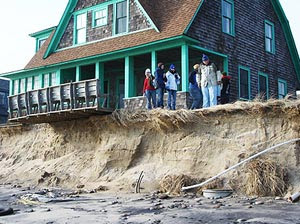CRMC Nixes Wall Exemption for Matunuck Beach
By DAVE FISHER/ecoRI.org News staff
At the April 10 meeting of the Coastal Resources Management Council (CRMC), the governmental body charged with protecting Rhode Island ’s 400 miles of shoreline, South Kingstown officials sought a special exemption from the CRMC to install a sheet-pile wall directly adjacent to Matunuck Beach Road
 |
| Erosion has been a problem at |
Testimony in support of the exemption was offered from town manager Steven Alfred, and designers and engineers of the proposed wall.
Alfred testified to the need for the wall to protect public safety. "Matunuck Beach Road
There is no other road or water service to those homes. Alfred also testified that the town would be content to limit the special exemption to a 202-foot stretch of the proposed 1,400-foot-long seawall. “We believe that the special exemption should be granted through the CRMC’s public infrastructure exception rule,” he said.
Alfred assured the council that the town has explored viable alternatives, such as moving the road and building new access roads, but determined that other options weren't practical or economically viable, mostly due to the need to destroy or move homes to build new roads. He also noted in his testimony that, in the nine months since the engineering study, 15-20 more feet of erosion had occurred.
Wall engineer and designer Rick St. Jean testified that the proposed wall itself wouldn't cause additional erosion due to it being erected behind existing seawalls, and that the proposed wall would only come into play if the existing wall failed. Under cross-examination by lawyers representing various home and business owners in the Matunuck area, he admitted that the wall is only a short-term solution, with an expected lifespan of 20-40 years, and would require maintenance by the town.
CRMC engineers expressed concern in their report to the council about increased surges on the landward side of the wall during storm and flood events and the strength of the wall during intense weather events such as hurricanes and back-to-back Nor’easters.
Sheet-pile walls are installed without excavation. The three-eighths to half-inch thick sheets of steel are driven directly into the soil with a piledriver. CRMC member Tony Affigne expressed concerns over the effects of the installation of the wall on the existing seawall and the possible disruption of softer soils that, in some spots, extend only three to six feet seaward of the proposed wall.
The fact that the beach isn’t owned by the town presents some difficulty concerning future erosion and infrastructure protections.
Legal representatives of home and business owners, and advocacy groups such as the Surfrider Foundation stressed the fact that this plan, and the testimony of Alfred and St. Jean
Stephen Reid, legal counsel for the owners of the Ocean Mist restaurant, pointed to the lack of a return on the proposed wall, and said that his clients would bear the brunt of wave erosion when the wall is inevitably exposed.
Brian Wagner, representing the Rhode Island
The town has refused free sand for beach renourishment on more than one occasion.
Jane Austin, senior policy analyst at Save The Bay, said, “Hardening shorelines encroaches on the public trust, decreases property values and increases erosion on adjacent beaches. These problems will only be magnified by sea level rise and climate change.”
Matunuck resident Robert Cavanaugh expressed support for the proposed wall, but seemed to be using the same language as opponents when he said that previous methods of preserving the beach and road were akin to “putting Band-Aids on a bleeding patient.”
Attorney for the MC Homeowner’s Association, Donald Packer, representing 288 homeowners in the Mary Carpenter's Beach neighborhood, voiced support for the special exemption and a further proposal to reclassify the beach in question as “manmade.”
Sean Coffey, representing several business and homeowners located directly on Matunuck beach, expressed his clients’ opposition to the proposal, saying, “It seems the town will protect the road at all costs, and they will continue to chase this erosion down the beach. Their concern should be to protect the natural infrastructure of the beach, and address not the road, but the true problem, which is beach erosion.”
The original application for the special exemption was filed last October. In the interim, CRMC staff reviewed and assessed the proposed plan. Its findings didn't support the town’s application for exemption, and based on the staff report and testimony and public comment offered at the meeting, the CRMC voted 7-2 against the exemption.
The next CRMC meeting, to held April 24, will address the town’s proposal to reclassify the beach as “manmade.”
For more information on the effects of coastal erosion and beach renourishment, click here.
